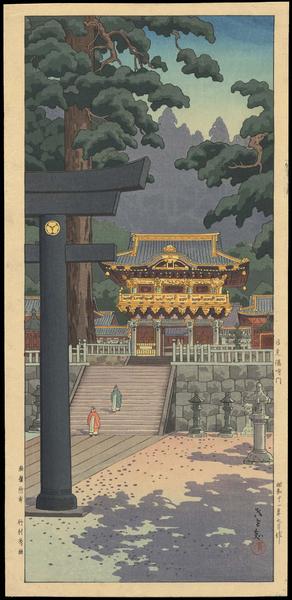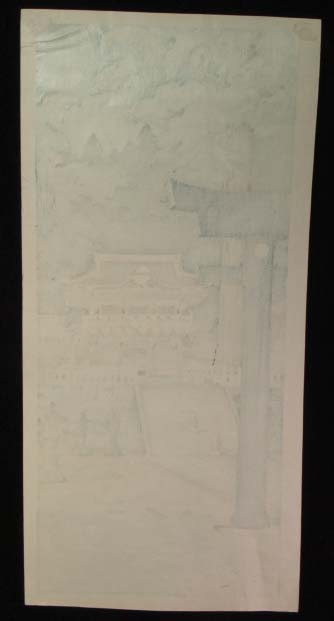| | |
| Artist: | Tsuchiya Koitsu (1870-1949) — 土屋光逸 |
| Title: | Nikko Yomeimon |
| Series: | |
| Date of first edition?: | 1936/7 |
| Date of this artwork?: | 1936 July (may not be accurate) |
| Publisher (first edition)?: | Takemura Hideo — 竹村 |
| Publisher (this edition)?: | Takemura Hideo — 竹村 |
| Medium (first edition): | Woodblock |
| Medium (this edition): | Woodblock |
| Format (first edition): | Mitsugiri
|
| Format (this edition): | Mitsugiri |
| DB artwork code: | 38608 |
| Notes (first edition)?: |
|
| Notes (this edition)?: |
| The following information was taken from the original web listing of this artwork. Note that there may be some inaccuracies:
Sunday, 6 November 2005
This piece measures 7.25” x 15.25” and this is an original woodblock print titled the “Yomemimon Gate” featuring the main gate of Nikko Shinto Shrine. Nikko Toshogu Shrine is located in Tochigi Prefecture of Japan and the third Shogun Iyemitsu, the grandson of the first Shogun Tokugawa Ieyasu, built it. It is the mausoleum of Ieyasu who is one of the most important figures in Japanese history, the founder of the Tokugawa Shogunate that lasted for over 250 years until 1867. The Toshogu Shrine is very famous for its colorful and sumptuously decorated buildings that are unlike the typical simple styled built Shinto shrines.
Yomeimon gate (Gate of Sunlight) is an incredibly ornate structure carved by some 130,000 craftsmen with an unlimited budget. Fearing the gods will be jealous of its beauty and the presumption of perfection, one of the gate’s columns was deliberately placed upside down. The construction exemplifies the highest development of applied arts of the Edo period (1603-1867) of Japanese history and the grandest example of Chinese influence in Japanese shrine architecture.
The artist “Kiyoshi” had opted to place the ornate gate in the back but he was still able to draw ones attention to its gleaming gold decoration of the gate by contrasting with the dark Torii Shinto gate in the front. Since only half of the Torii gate is shown on the left shows that it is actually the background of this piece even though it is placed in the front so that the eyes are designed to focus on the Yomeimon gate. The two Shinto priests are approaching to the main gate among the deep trees emphasizing the quiet solitude. The writing on the side reads “Yomeimon Gate, July 1936” and the name of the artist is Kiyoshi, though his last name is unknown. The name of the publisher is shown on the left margin of the piece that reads “Takemura Hideo.” The condition of this piece is still very good though there is a wave indentation in the top right corner and rice glue mounting residue on the top two corners on the verso. |
|
| Artist Bio: |
| Please see my website www.koitsu.com to view all currently-known works by Tsuchiya Koitsu.
明治03年(1870年) 静岡県浜松市に生まれる 姓土屋 名は光一
明治18年(1885年) 15歳の時に上京し、始めは木版彫刻師の弟子になる
明治19年「1886年) 小林清親に入門(以降明治37年までの30年間、小林家で家族同様に生活の苦を共にする)
明治28年(1895年) 代表作として日清戦争を描いた「講和使談判之図」や「万々歳凱旋之図」などがあげられ、色彩も温和である
明治31年(1898年) 石版画を版行した版元として松聲堂から明治37年(1904年)に版行された「教育歴史画」第一輯から第三輯など
明治35年(1902年) から明治36年(1903年)に版行された「教育立身画」などの石版画の作例あり
昭和05年(1930年) 東京尚美堂から発表した木版画として横三つ切判「宮島」、「天の橋立」、「松島」などがある
昭和07年(1932年) 渡辺版画店から新版画「祇園の夜桜」、「大阪城の月夜」の2点を版行
昭和08年(1933年) 土井版画店より細判風景画「奈良猿沢の池」、「雪の堅田浮見堂」(東京国立近代美術館所蔵)、「日比谷の月」、「弁慶橋」などあり
昭和11年(1936年) 「東京風景十二枚」を同じく土井版画店より版行しており、清親ばりの風景版画を残した
昭和11年(1936年) 9月、「下関観月橋」を馬場信彦のもとから発表した後、昭和16年6月まで大判16枚などの作品を版行した
昭和16年(1941年) 頃まで東京尚美堂、酒井川口合板、カワグチ商会など各版元から新版画の作品を発表していった
昭和24年(1949年) 11月、79歳で没した 明治時代から昭和時代にかけての浮世絵師、版画家
|
|



